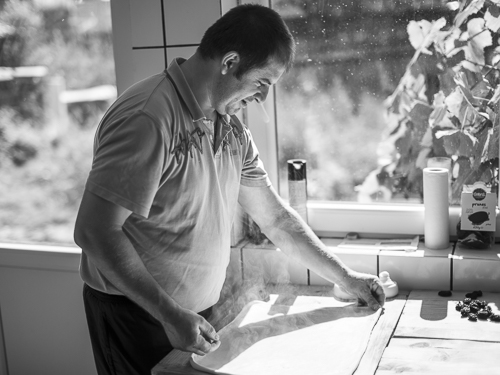The Sterczer farm is located inside the village of Sânzieni (Romanian)/Kézdiszentlélek (Hungarian) and it surely shows how Western European villages were organised in the past: small farms surrounded by houses.
The farm has about 16 cows, which are always inside wooden barns, while 3 calves, of which the 2 males would be slaughtered later, stayed in a shed. Regarding my question about why the cows weren’t outside, he said that common land was 10 km away and it was too long for the cows to walk there. Besides, there had been a drought such that there was little to eat for the cows. Instead, the farmer grows enough hay on his farm to feed the cows all year.
The farmer told my guide that he was born at this farm, but moved around a lot in his childhood and he learnt farming from his aunt and uncle. He bought this farm with his own money and he hasn’t got anything from the EU.
The Sterczer family is expanding the farm slowly, increasing the number of cows and buying required equipment when possible. He had a serious illness due to stress 6 years ago. Then, he sold all the cows, but kept some calves. As they grew up, he sold raw milk to the villagers, but never to dairies because they pay next to nothing for milk. Actually, the locals prefer to buy milk from milk dispensing machines.
Since cheese is more expensive, he wanted to make cheese. He started reading about cheesemaking, then he went to courses about it. A breakthrough happened when he met a Swiss cheesemaker 3 years ago.
The farmhouse dairy is located near the farmhouse of the Sterczer family. Inside, both floors and walls are covered by tiles, all necessary equipment for making cheese is ready for use, while a basement with more or less constant low temperature and high relative humidity is used to store cheeses. In fact, the farmhouse dairy is too small and needs to be expanded, but it will have to wait for now.
When he goes to fairs and markets, people want to pay as little as possible. However, by offering everyone at least one free sample, some people get interested and want to taste more and even pay the price he requires.
During our visit, the farmer heated water and a little salt in a kettle. Next, he put some grated cheese in a sieve and put it in the hot water, letting the cheese start melting. Next, he formed the cheese into a clump and put it on a table where he flattened it by his bare hands, while water vapour was rising from the cheese. Before, I’ve been watching bakers picking up steaming hot bakery products straight from an oven. I suppose that both the farmer and the bakers have made the skin of their hands resistible to heat, which would burn the palms of the rest of us.
Next, he put a row of prunes along the short side of the flattened cheese before rolling the cheese around the prunes. He also did the same with slices of ham, spices and dried herbs. When the cheeses were finished, he would let them be smoked such that the surface of the cheese would have a dark yellow shade and also make it more tasty. This way of making cheese comes from Slovakia, but it’s his idea to add prunes to the cheese. He likes to experiment and he may come up with another cheese, which will be appreciated by his customers.
While the farmer was showing us how he made rolled cheeses, his wife and daughter prepared a tray of their rolled cheeses and I have to admit that I liked all of them.
This farmer makes 2-3 types of cheese, while he says that a good cheesemaker only makes one.

